
The Lepalepa
Bugis Outrigger Sailing Canoe of Sulawesi

| The Bugis ethnic group of Sulawesi are famous for their maritime exploits. These exploits once included enough piracy to inspire our word "boogey-man" or "bogey-man". Today their huge fleet of wooden "Pinisi" ships carry freight all around the islands of S.E. Asia. Less known are their outrigger canoes. Here's one particularly cute example of the "Lepa-lepa". Syamsuryadi aka "Syamsu" built it in 1999 for fishing. It carries one person and is one of the fastest canoes in the village. "as fast as a motorboat". He keeps it on the beach across from his house in the village of Sapolohe on the outskirts of the shipbuilding village of Bontobahari, in Bulukumba district of Sulawesi, near Bira at the southern tip of the island. He kindly let me measure it and hopefully people all over the world will start building their own. |  |
|
Dimensions: |

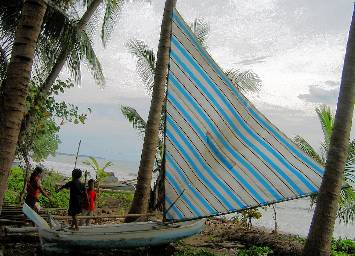

1 2 3 4 5 6 7 8 9 10 11 12 13 14 15 16 17 18 19 20 |
somang barratang ripasan layar tali tari or panambera tampaduru panahan panta perahu tas punaha layar jankar ponoto somang dayun gincheri guling komodi sankilang tompa sankilang sompat layar |
ama or outrigger aka or crossarms boom sail stay sheet seat bamboo fore-aft pole lashed across akas stem lashing mast thwart anchor carved tip of outrigger paddle tiller rudder rudder+tiller upper rudder support- looks like horns lower rudder support sail rest |

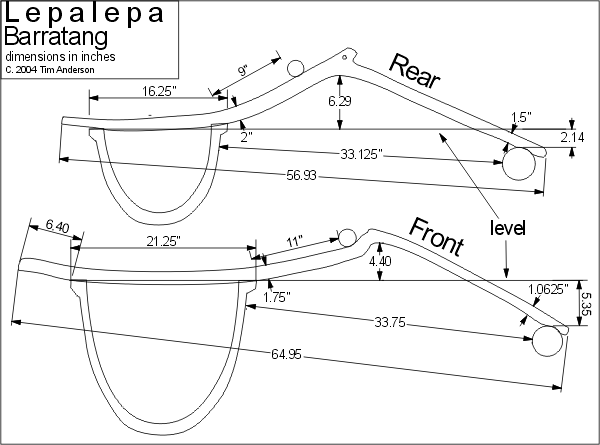
Rudder, Tiller and Sankilang

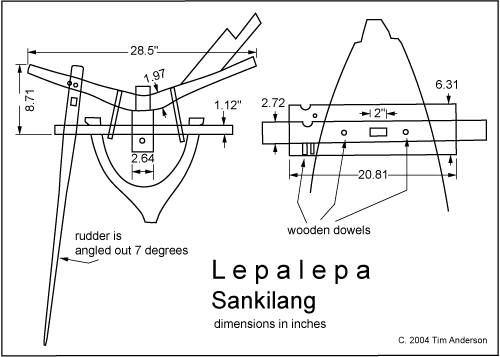
 |
This bench goes in front of the back beam. There are carved lugs projecting on the inside of the hull for it to rest on. The split-bamboo lattice is only attached at the front. It can be lifted to stow lunch and fish underneath, or keep a live crab or lobster from running away. The sticks are interlaced with monofilament to make them like a roll-top desk cover. There's also another little block-and-board bench to rest ontop this one so you can sit at gunwale height. |
 |
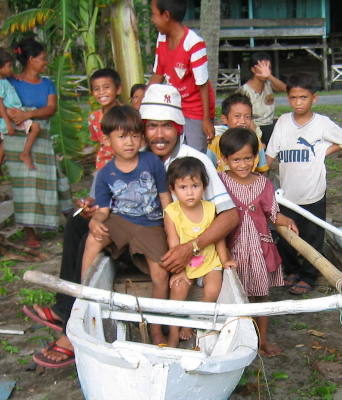 |
| Taking the lines. The kids are having a good time. Their fingers indicate section shot 11. This technique is from the book "Clean Sweet Wind". | Syamsu, children and friends. |

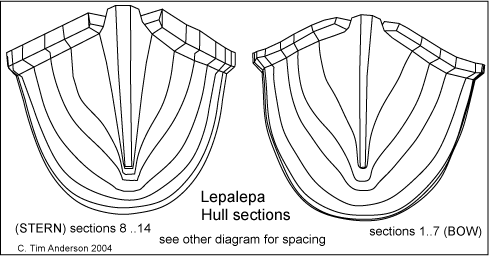
  |
| A similar canoe about 12 ft. long on the beach between Bira and Marumasa on the east side of the peninsula. There are several just like it in a row here as well as paddling canoes with the same hull. Very low freeboard and no splash rails. Note the sankilang (rudder support) Some are very elaborate. The bamboo cup will hold a hurricane lamp made from a plastic bottle for night fishing. This canoe is a one-piece dugout. Syamsu's is a seven-part canoe, with a dugout bottom, a wash strake on each side, bow pieces at each end and splash rails/gunwale caps running the length. |
 |
 |
 |
|
One of several one-legged paddling canoes on the beach
at Marumasa. They also use them without the outrigger and stay upright
by magic.
|
Smoothing a bamboo outrigger, Marumasa
|
Sulawesi double outrigger fishing canoes. Thousands line
the beaches between Makassar and Tanaberu.
|
 |
| Tana Beru beach south of Bontobahari. Wooden ships being built as far as the eye can see. Third from right is "Nagasaki Dream" a Japanese man's floating hotel project. Stalled for lack of funds after spending about $60,000us according to my informant. Make an offer? Lots of worm proof ironwood in it, and those trees are all gone from Sulawesi and Borneo now. By the time you read this they'll be gone from Papua too and you'll be spending all your money on air to breathe. All because Americans bought too many futon couches made from tropical hardwood. |
The Rhino 3.0 CAD files of the canoe are in this directory of drawings, along with the 2d drawings in various formats. Many more photos of the canoe are here.
c.Tim Anderson 2004